Remembering once again that I don’t do enough Bronx posts, I set off on one of the most brain-meltingly humid days of the summer to parade around the near geographical center of the Bronx, Crotona Park, Mount Eden and High Bridge.
Crotona Park, the neighborhood and the park, is nowhere near the Croton Aqueduct, which runs through the western Bronx; it was named for a colony in ancient Greece famed for Olympic athletes. It was purchased from the estate belonging to Andrew Bathgate in the 1880s; a dispute with the Bathgate family prevented the new Crotona Park from being named for them. Bathgate Avenue today remembers these early Bronx gentry.
GOOGLE MAPS: CROTONA PARK to HIGH BRIDGE
I grabbed the #5 train from Grand Central and rode to Freeman Street. The mid-Bronx features the same numbered east-west streets as Manhattan, as if the Harlem River didn’t separate the two boroughs; the Bronx borough separated from Manhattan borough in 1898, and Bronx became its own county in 1914. But the Bronx also has a large contingent of named east-west streets mixed among the numbers, such as Freeman, named for Dr. Norman Freeman, who taught at St. John’s College, now Fordham University, from 1845 to 1850.
The IRT el station at Freeman at Southern Boulevard was one of the first elevated uptown extensions of Interboro Rapid Transit, opening on November 26, 1904, just one scant month after the IRT subway opened between City Hall and 145th Street in Manhattan. It is a northern extension of the Lenox Avenue IRT branch.
The colorful stained glass artwork by Daniel Hauben, “The El,” was installed in 2006.
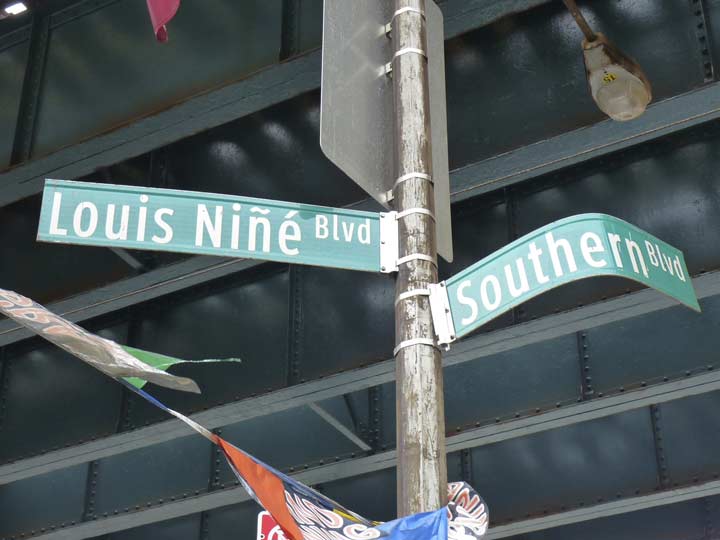
This new street sign leaves no possibility of error in the pronunciation of Louis Nine Boulevard: it’s Louis NEEN-yay, not “Louis 9”. The street was renamed from Wilkins Avenue soon after the 1983 death of Bronx assemblyman Nine, whose name is spelled without the accents in his NY Times obituary. Louis IX, meanwhile, was a Crusading 13th Century French monarch and the only one made a saint by the Catholic Church.
The era of total street renaming seems to have come to an end, as streets get “sub-names” these days on separate street signs, with the original name allowed to remain in place.
Charlotte Street, a three-block thoroughfare running from Crotona Park East across Boston Road to Jennings Street and Minford Place, was briefly the best-known, and most infamous, street in the Bronx in the late 1970s. The young Quaker lass named Charlotte Leggett would never know that by marrying into the prominent Fox landowning family in 1808, she would eventually have a short street in the immediate Crotona Park area named for her; apartment buildings housing middle-class workers would spring up; and that her street would decay and collapse into utter ruin before bouncing back to respectability.
The street became a microcosm of what was happening to the South Bronx in the 1960s and 1970s when the high cost of illegal drugs caused many to commit crimes to pay for their habit. Merchants, many of whom had been in business in the neighborhood for decades, and many residents moved out to escape the onslaught. Landlords found it was unprofitable to maintain their buildings when the junkies were trashing them. By 1970 half the families living on Charlotte were welfare families and monthly rents became hard to collect. After a while heat and hot water was not provided and some unscrupulous landlords turned to arson to force recalcitrant tenants out. That same year, over 4200 fires broke out on Charlotte, an average of eleven per day. It was a nightmarish scenario that saw most of the buildings on Charlotte burnt down or abandoned by the mid-1970s.
President Jimmy Carter was in New York to attend a United Nations session October 5, 1977, but his real mission had been cloaked in secrecy to all but his closest aides. Carter wanted to see for himself the devastation that had been wrought on Charlotte Street. His motorcade roared on streets that have almost never seen visits by mayors, much less Presidents: the Grand Concourse, East Tremont Avenue, and Third Avenue, whose El was so recently torn down; its burned-out buildings bore sheets of tin where the window glass used to be. The motorcade traveled down Claremont Parkway (see below), at one time a genteel carriage road between the Bathgate and Zborowski estates; through Crotona Park, whose grand appointments were now rubble-strewn; and on Boston Road, conceived and built by Lewis Morris in the post-Revolutionary years as an alternative to the older Boston Post Road; and finally Charlotte Street. The massive Herman Ridder Junior High School (see below) loomed balefully over the rubble-strewn blocks, the school standing out now that mostly everything surrounding it had been lost.
A week after the President’s visit the Yankees opposed the Los Angeles Dodgers in the World Series at Yankee Stadium. The nation saw for itself the Bronx’ plight when between innings, ABC-TV cameras panned around on the numerous blazes visible in the night. “The Bronx is burning,” intoned Howard Cosell.
The south Bronx was slow to recover. The federal government promised only $55 million in the wake of Carter’s visit. In 1977, the crack and AIDS epidemics were yet to arrive. Drug overdoses and AIDS killed over 17,000 Bronxites between 1985 and 2000. But the seeds for Charlotte Street’s rebirth began to bear shoots in 1984 when Charlotte Gardens, a community of ranch houses, was constructed where all the old tenements had burned down. Applicants who could prove need were able to purchase new $52,000 three-bedroom houses. Soon, additional new housing sprouted on the battered streets to the south and east.
The Crotona Park area remains an “urban frontier.” New housing and middle-class residents still must battle the residue of the crime and drug plague left over from the last four decades of the 20th Century. But the neighborhood is immeasurably improved from what it was a mere 30 years ago.
ForgottenFan Mark Nahmias:
Give credit where credit is due. Although President Carter visited in 1977 there was no real progress on area rehabilitation until the Reagan administration. Charlotte Gardens debuted at the end of Reagan’s first term. Naturally, biased drive-by media will never admit to it. Reagan succeeded while Carter merely “visited”, but, hey, weren’t his intentions just wonderful? The 2 youths in the 1980 photo were probably so impressed by them. I hope they’re homeowners today. Thank you, President Reagan.
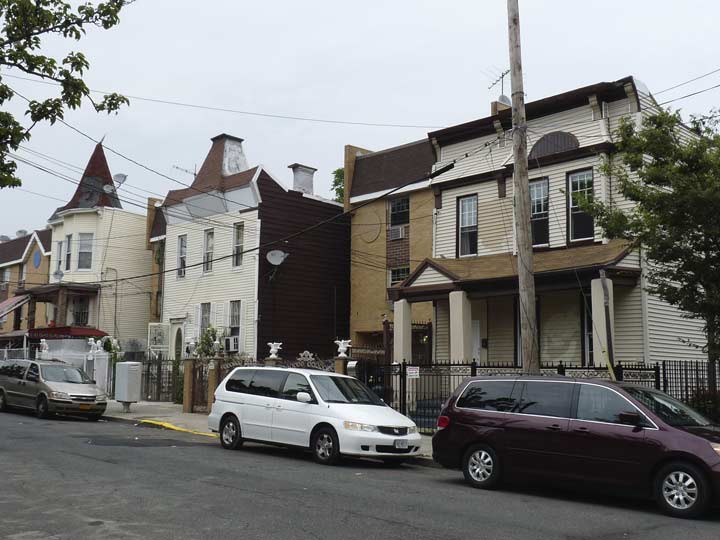
Houses on Minford Place near Charlotte Street. These buildings probably predate the arson wars, though they have had heavy aluminum siding applied since.
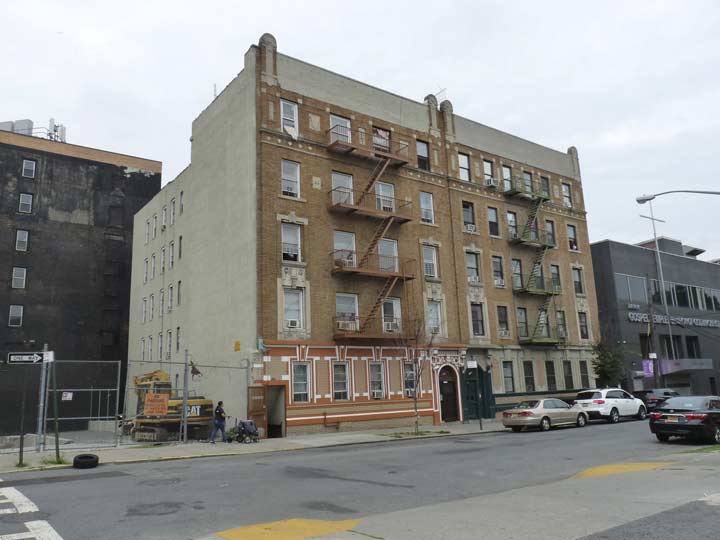
Pre-World War II apartment building on Minford Place and East 173rd street, likely another such survivor.
This is a junior high school?
Intermediate School 98, Hermann Ridder Junior High, 1619 Boston Road at East 173rd Street, is a massive stone fortress for learning built from 1929 to 1931 by architect Walter C. Martin in the then-new Art Deco style, which he melded into the Beaux Arts stylings of the previous decades. It has always been a junior high. When up close, look for sculptures of books and lamps of knowledge; when riding north on the #2 train, gape at it with awe as it goes by.
Its namesake (1851-1915) was a successful magazine and newspaper publisher; he ran into trouble at the start of WWI because of pro-German sentiment in the pages of one of his publications, New Yorker Staats-Zeitung; he also published The Journal of Commerce, which I recall from my days working at the Brooklyn Business Library between 1978 and 1981. The business was carried on by his son Victor Ridder; in 1974, Ridder Publications merged with Knight Newspapers to become Knight-Ridder, the second-largest newspaper publisher in the United States until its sale to the McClatchy Company in 2006.
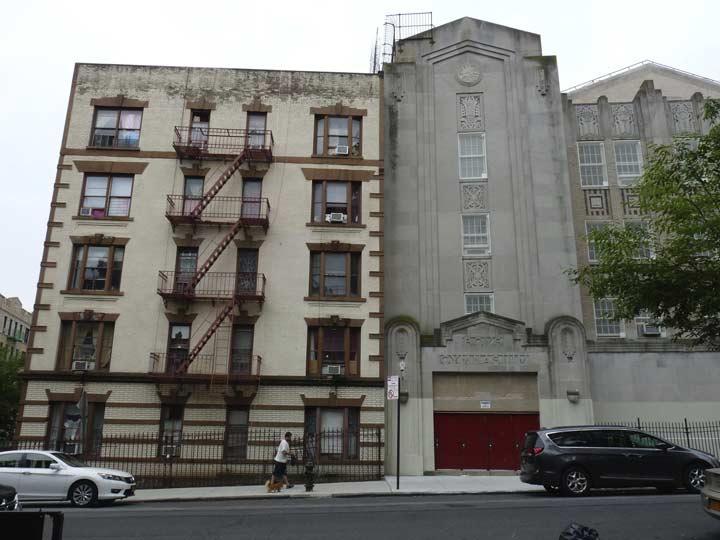
The junior high “wraps around” this corner apartment building at Crotona Park East and East 173rd Street. One of the two separate gymnasium entrances, one each for boys and girls, is at right.
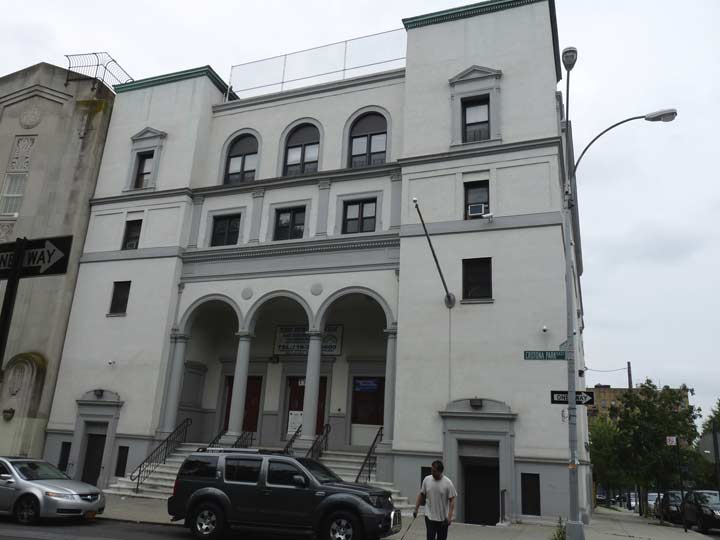
The most lavish day-care center I’ve ever seen at 1600 Crotona Park East and Suburban Place. It reminds me a great deal of the Morris Park stationhouse at the East 180th Street stop on the #2 and #5 trains.
This is on the corner of Suburban Place, which was named in 1887 when there was still a spring-fed pond at Suburban Place and Boston Road.

Francisco Oller School, Crotona Park East. Oller (1833-1917) was a Puerto Rican Impressionist painter.
After the city took title to the Andrew Bathgate Estate in 1888 it converted some of the estate to parkland. The park, which became known as Crotona Park not from the aqueduct but from a city in ancient Greece, eventually encompassed over 127 acres and became known for its excellent views: the New Jersey palisades and the Brooklyn Bridge are visible from its heights in winter.
On the grounds of the Bathgate estate there was a small pond, named by neighborhood children Indian Lake generations ago, complete with a brook that trailed off to the south, eventually entering the East River.
The stream, now underground, follows the paths of Rev. James Polite Boulevard, Intervale Avenue and East 149th Street to the river.

Beginning in the 1930s, the Works Progress Administration and Parks Department head Robert Moses modernized Crotona, constructing a boathouse (above), baseball diamonds, tennis courts, handball courts, bathrooms, and a swimming pool and bathhouse. Unfortunately the lake could use some algae treatments.
I encountered a fellow with his son and a pet parrot and another practicing the trombone in Crotona Park.
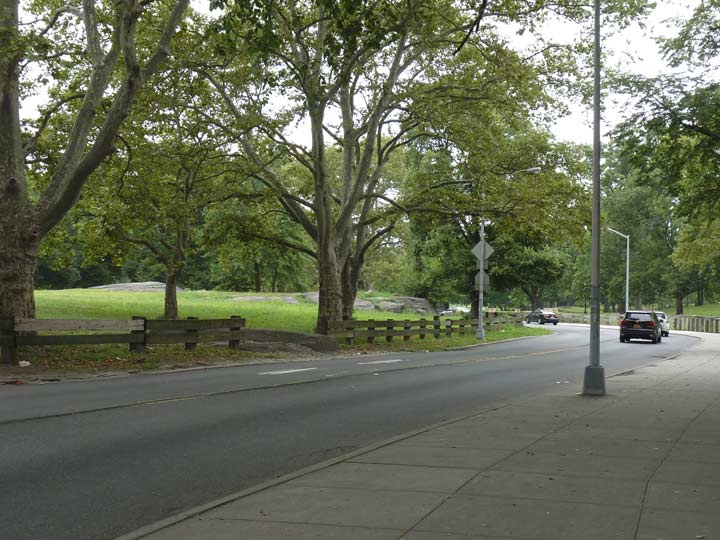
While Crotona Avenue bisects the park from north to south, Claremont Parkway (above) crosses it from east to west. The parkway, which resembles a junior version of Pelham or Mosholu Parkway here, connects Crotona Park on its east end with Claremont Park on its west end. (There is also a Crotona Parkway, which is a running buddy of Southern Boulevard between East 175th and Bronx Park South and doesn’t touch Crotona Park at all, if things aren’t confusing enough.)
Next week: Claremont Park and Mount Eden
10/16/16


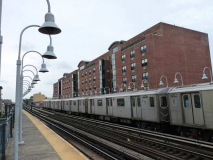
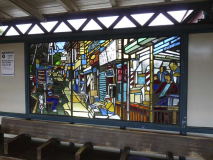
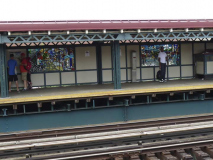
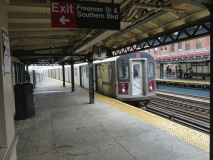
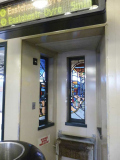

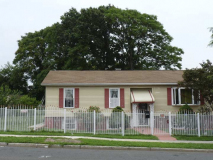
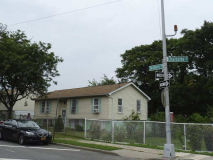
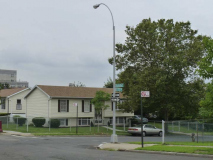
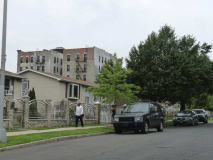
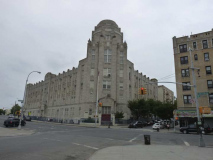
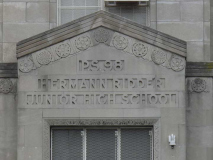
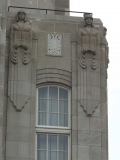
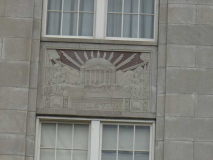
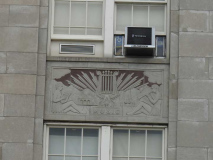

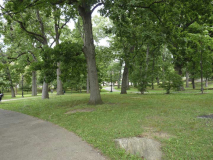
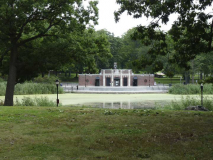
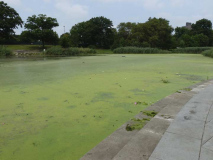
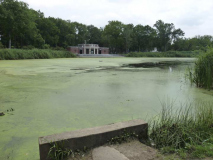
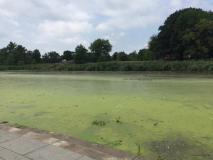
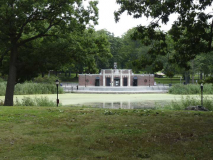
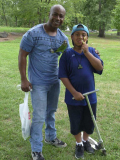
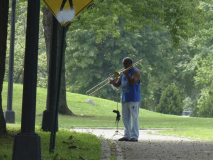
10 comments
awesome. another like mind who loves the Bronx. great factoids!!
Very cool! (Btw, Highbridge is one word when talking about the Bronx, two words when talking about a town in NJ.)
Any relation to Billy Kil? Gene Tortone
This is great. it brings back memories. We lived in Seabury Place, Minford Place in the 60’s. I went to school at P.S. 61. My brother went to school at Herman Riider. We use to go to Crotrona Park. Great seeing these pictures. Much cleaner now. It is nice seeing single homes where buildings use to be.
I lived at 1464 Seabury Place and went to P.S.61. Mrs.Hildebrandt was principal and Mr. Silverman or Silverstein and Mr. Sontag were vice principals. There was a school dentist with a very creepy assistant with bulging sins in her forehead! Scared the hell out of me and my friends, Joe Fedak and Jose Sierra whenever we saw her!
The “lavish day care center” at 1594/1600 Crotona Park East & Suburban Place started out in 1924 as a synagogue, Congregation Kehilath Israel. My parents were married there in 1945.. Some sources say that the building ceased to be a synagogue in 1966, although I suspect that 1960 may be a more accurate.year.
Real nice to find historical background. I’d gone to P.S. 66 till 1963 and am trying to learn about the area.
Ty for this. I am interested in the history of the public schools in The Bronx, when built, what architectural style & the original ethnic/racial mix of children who attended. I’m a Teachers College alum with Masters in the history of Social Studies curriculum reforms, which focused on “Americanizing” immigrant children in urban schools.
This link is all about Ridder JHS and its architecture for those who want a deep dive:
http://www.neighborhoodpreservationcenter.org/db/bb_files/90-HERMAN-RIDDER-J.H.S..pdf
I have been researching the Bathgates of West Farms, New York for several years. There was no Andrew Bathgate- Crotona Park was part of the estate owned by the children of. Charles Bathgate (died 1847). Other NY references quote “Alexander” Bathgate-sometimes misrepresented further as “Andrew”. There is no evidence that an Alexander Bathgate existed, no census/no marriage/no children/no death. I think this is a classic example of original incorrect information being taken as correct in subsequent publications. Sorry folks-this wee Scotsman disnae believe the correct facts have been reported!